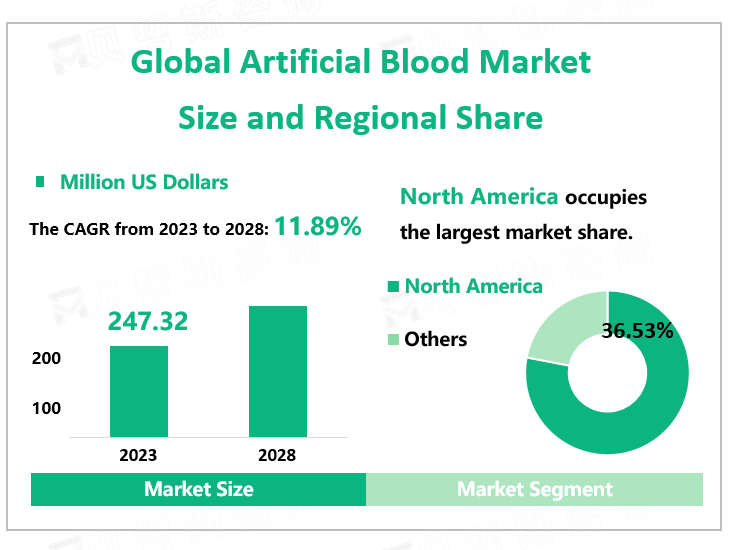Global Artificial Blood Market Overview
According to Global Market Monitor, the global artificial blood market size will reach $247.32 million in 2023 with a CAGR of 11.89% from 2023 to 2028.
Artificial blood refers to the hemoglobin that can replace the oxygen in human blood and is used for the sole purpose of transporting carbon dioxide and oxygen to the body. It does not have the full functioning capabilities of a red blood cell.
North America Leads the Artificial Blood Market.
North America led the global artificial blood market due to higher demand and supply of artificial blood, advanced research and development in the synthetic blood market, and increased investment in the artificial blood industry with a market share of 36.53% in 2022. On the other hand, in Europe, the market is driven by factors such as increasing awareness of artificial blood, government initiatives to increase access to products, and advanced healthcare infrastructure. In countries such as China and India, the market is estimated to witness tremendous growth due to the rise in the prevalence of chronic disease, higher cases of trauma injuries, and lower blood supply with an increase in demand. Latin America, the Middle East, and Africa are projected to register comparatively slower growth than other regions due to limited awareness regarding artificial blood.

Artificial Blood Performance Advantages
Artificial blood can be stored longer than normal blood. Thanks to the inspiration of blood transfusion, if the future replacement blood can be a product with a single functional component, it will be expected to be stored at room temperature for several years. Normal blood can only last 42 days.Artificial blood can withstand more demanding environments, such as not requiring refrigeration, and can be used in a pre-hospital environment.Artificial blood substitutes provide higher oxygen applicability by providing higher oxygen-carrying capacity, saving time in traumatic cases and battlefield situations, reducing the risk of infection, avoiding screening and cross-matching, and reducing overall costs.Ordinary blood transfusions must match their blood type or O-negative "universal donor", while artificial blood is suitable for everyone. Patients who cannot accept blood donors due to their religious beliefs will also benefit from blood substitutes derived from non-blood products.
|
Market Drivers |
Increased surgery |
|
Insufficient blood donation |
|
|
Wider audience |
|
|
High Quality |
|
|
Challenges |
Regulation from Government |
|
High Cost |
|
|
Side Effect |
We provide more professional and intelligent market reports to complement your business decisions.